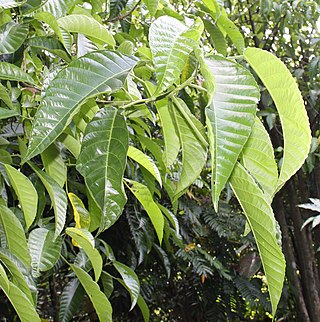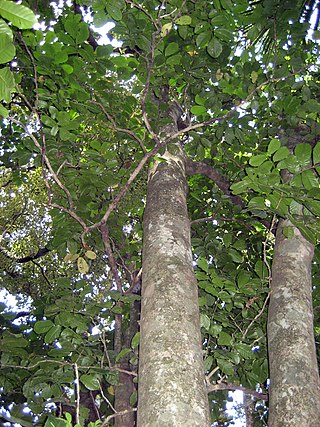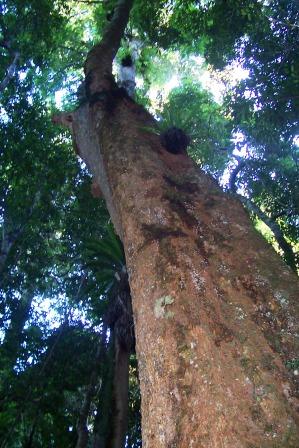
Meliaceae, the mahogany family, is a flowering plant family of mostly trees and shrubs in the order Sapindales.

Dysoxylum is a genus of rainforest trees and shrubs in the flowering plant family Meliaceae. About 34 species are recognised in the genus, distributed from India and southern China, through southeast Asia to New Guinea, Solomon Islands, and Australia. The name Dysoxylum derives from the Greek word ‘Dys’ meaning "bad" referring to "ill-smelling" and ‘Xylon’ meaning "wood".

Dendrocnide is a genus of approximately 40 species of plants in the nettle family Urticaceae. They have a wide distribution across North East India, Southeast Asia, Australia and the Pacific Islands. In Australia they are commonly known as stinging trees.

Kohekohe is a medium-sized tree in the Meliaceae family, native to New Zealand. It is found in lowland and coastal forests throughout most of the North Island and also occurs in the Marlborough Sounds in the north of the South Island. Mature trees grow up to 15 metres (49 ft) in height, with a trunk up to a metre in diameter.
Pseudocarapa is a genus of flowering plants in the family Meliaceae. It includes five species which range from Sri Lanka to Sumatra, Peninsular Malaysia, Borneo, and New Guinea.

Didymocheton fraserianus, commonly known as rosewood or rose mahogany, is a medium-sized to large tree native to New South Wales and Queensland. It is widely used with the purpose of street design and to provide shade in the eastern suburbs of Sydney. Rosewood ranges from the rainforest around eastern Australia from Bundaberg in Queensland to Wyong in New South Wales. At maturity, it can reach a height of 57 metres (200 ft). It is generally known for its strong scent of rose from its bark.

Didymocheton is a genus of flowering plants in the family Meliaceae. It includes 41 species which range from eastern India through Indochina and southern China to Malesia, Papuasia, eastern Australia, New Zealand, and the South Pacific.
Goniocheton is a genus of flowering plants in the family Meliaceae. It includes four species which range from Indochina to south-central China, Taiwan, Malesia, Papuasia, Vanuatu, and Queensland.
Prasoxylon is a genus of flowering plants in the family Meliaceae. It includes seven species which range from Nepal and eastern India through Indochina to southern China, Taiwan, Malesia, Sri Lanka, Papuasia, and Queensland.

Didymocheton muelleri, the red bean or Miva mahogany, is a rainforest tree in the family Meliaceae. It occurs in tropical, sub-tropical and littoral rainforests in eastern Australia, from the Bellinger River in New South Wales in the south, to the wet tropics of north-eastern Queensland. A signposted red bean tree may be seen near the car park of Victoria Park Nature Reserve in north-eastern New South Wales.

Didymocheton pachyphyllus is a small tree in the family Meliaceae, endemic to Lord Howe Island. It grows up to 15 m (49 ft) tall, and is found at all elevations on the island.

Didymocheton pettigrewianus, commonly known as spur mahogany, spurwood, or Cairns satinwood, is a large tree in the family Meliaceae. It is native to the rainforests of Malesia, Papuasia and Queensland. In Queensland it occurs only in a small part of the northeast coast.

Chisocheton is a genus of trees in the family Meliaceae. The genus name comes from the Greek schizos and chiton meaning "split tunic", referring to the lobed staminal tube of C. patens. Their range is from India and tropical China, throughout Malesia and south to New South Wales and Vanuatu.

Goniocheton arborescens, commonly known in Australia as Mossman mahogany, is a small tree in the mahogany family Meliaceae. It is native to rainforests of Malesia, Papuasia, Queensland and nearby islands.
Didymocheton mollissimus is a species of tree in the family Meliaceae. It ranges from eastern India and Bangladesh to southern China, Myanmar, Thailand, Peninsular Malaysia, Borneo, Sumatra, Java, the Lesser Sunda Islands, and the Philippines, where it grows in lowland tropical moist forests.

Epicharis parasitica, commonly known as yellow mahogany, is a species of rainforest tree in the family Meliaceae native to Taiwan, parts of Malesia, Papuasia, and northeast Queensland.

Didymocheton gaudichaudianus, commonly known as ivory mahogany, is a species of rainforest tree in the family Meliaceae, native to Malesia, Papuasia, Queensland, and some southwest Pacific islands.
Epicharis is a genus of flowering plants in the family Meliaceae. It includes seven species which range from Indochina to south-central China, Taiwan, Malesia, Papuasia, Queensland, and Fiji.
Didymocheton alliaceus is a species of flowering plant in the mahogany family, Meliaceae. It is a tree native to the tropical Pacific islands, ranging from the Solomon Islands to the Caroline Islands, Vanuatu, Fiji, Wallis and Futuna, Niue, Tonga, and the Samoan Islands. It is most closely related to Didymocheton mollissimus of Malesia and mainland Southeast Asia, D. mollis of the Bismarck Archipelago, New Guinea, and Sulawesi, and D. muelleri of northeastern Australia.
Dysoxylum acutangulum is a species of flowering plant in the mahogany family, Meliaceae. It is a tree native to Peninsular Thailand, Malesia, New Guinea and the Solomon Islands, and the Northern Territory and Queensland in Australia.










